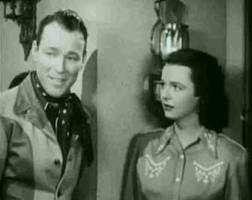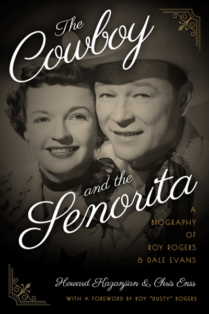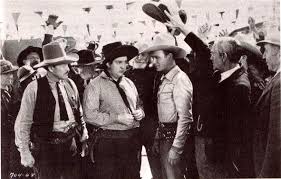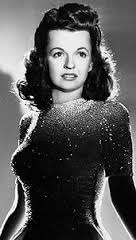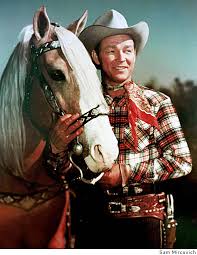Under Western Stars
An Essay for the National Film Registry
By
Howard Kazanjian and Chris Enss
King of the Cowboys Roy Rogers made his starring motion picture debut in Republic Studio’s engaging western musical Under Western Stars. Released in 1938, the charming, affable Rogers portrayed the most colorful Congressman ever to walk up the steps of the nation’s capital. Rogers’ character, a fearless, two-gun cowboy and ranger from the western town of Sageville, is elected to office to try to win legislation favorable to dust bowl residents.
Rogers represents a group of ranchers whose land has dried up when a water company controlling the only dam decides to keep the coveted liquid from the hard working cattlemen. Spurred on by his secretary and publicity manager, Frog Millhouse, played by Smiley Burnette, Rogers campaigns for office. The portly Burnette provides much of the film’s comic relief and goes to extremes to get his friend elected. His tactics include pasting stickers on the backs of unsuspecting citizens he engages in conversation and helping to organize a square dance to highlight Rogers’ skill and dedication to solving the constituent’s crisis. Using his knowledge of land and livestock and his talent for singing and yodeling, Rogers wins a seat in Congress.
The sweep of this picture, which moves rapidly from physical action on the western plains to diplomatic action in Washington and back again, is distinctively thrilling. The surging climax in the dust-stricken cattle country makes for one of the most refreshing films of its kind. The politicians Rogers appeals to about the drought are not convinced the situation is as serious as they are led to believe and decide to inspect the scene for themselves. The investigation committee is eventually trapped in a real dust storm. The shots of the storm and the devastation left in its wake are spectacular.
Roy Rogers came to Hollywood from Duck Run, Ohio. He made a name for himself as a member of the successful singing group the Sons of the Pioneers. Reigning box office cowboy Gene Autry’s difficulties with Herbert Yates, head of Republic Studios, paved the way for Rogers to ride into the leading role in Under Western Stars. Yates felt he alone was responsible for creating Autry’s success in films and wanted a portion of the revenue he made from the image he helped create. Yates demanded a percentage of any commercial, product endorsement, merchandising, and personal appearance Autry made. Autry did not believe Yates was entitled to the money he earned outside of the movies made for Republic Studios. He refused to include Yates in the profits and threatened to leave the studio if Yates did not reconsider. Autry was also demanding a raise in pay.
Yates decided it was time to begin grooming another talent to take Autry’s place should the need arise. Rogers was a contract player with the studio making $75 a week. Billed as Leonard Slye he appeared in a handful of films with Gene Autry singing along with the Sons of the Pioneers. Rogers even had a part as a bad guy in one of Autry’s films. When Autry caught up with Rogers in the picture, instead of taking him to jail he demanded the wily character yodel his way out of his troubles.
Yates had been looking for a musical actor to go boot-to-boot with Autry and Rogers was to be the heir apparent. His sweet, pure voice and wholesome image made him a natural for the hero in Under the Western Stars. Whether regaling the audience with a song about fighting the law entitled Send Our Mail to the County Jail or delivering a stump speech via a tune called Listen to Rhythm of the Range, Rogers makes the most of his leading role.
The Maple City Four, the well-known quartet who made the number Git Along Little Dogies popular, added their talents with Rogers harmonizing on the film’s most important song entitled Dust. Written by Johnny Marvin, a recording artist from Oklahoma, Dust was nominated for an Academy Award for Best Original Song. It was the first song from a B-western to be Oscar nominated.
According to the February 24, 1938, edition of the Hollywood Reporter, Dust was purchased by Republic Studios from the composers, Gene Autry and Johnny Marvin, for use in Under Western Stars. A subsequent news item in Hollywood Reporter on April 13, 1938, just prior to the film’s release, noted that Autry was suing the studio for $25,000 for unauthorized use and dramatization of the lyrics with Dust. According to contemporary sources, the suit over Dust was settled out of court and Johnny Marvin is listed as sole writer of the song.
Audiences made Under Western Stars a box office success and critics called its star “the new Playboy of the Western World.”
Director Joseph Kane, Republic’s top director of westerns delivered a film with a slight new slanting to make it different from all other B-westerns before it. In addition to the political intrigue in Under Western Stars there is a fair amount of gunfights, fast horses, and unforgettable stunts. What makes Kane’s film unique is that the fight is not over horse thieves, but the rights of man. Critics at the Brooklyn Daily Eagle newspaper sited Kane’s “sensitive directing eye with giving the horse opera a social consciousness.”
Actors Carol Hughes, Guy Usher, Tex Cooper, Kenneth Harlan, Curley Dresden, Bill Wolfe, Jack Ingram, Jack Kirk, Fred Burns, and Tom Chatterton round out the exciting cast of players and no happy ending would be possible at all if not for Roy’s magnificent Palomino horse Trigger. Brothers and veteran western writers Dorrell and Stuart McGowan penned the screenplay for Under Western Stars along with actress and screenwriter Betty Burbridge.
The film was shot in the Alabama Hills of Lone Pine, California. The scenic location has been used for the backdrop in hundreds of motion pictures and television programs. The high desert surroundings are integral to the story line of Under Western Stars and could be billed as a supporting role in the film.
Roy Rogers’ first starring vehicle solidified his place as a rising star in B westerns. Film writer and critic Louella Parsons likened Rogers to “Gary Cooper in personal appeal.” According to her report with the International News Service on November 29, 1938, she called Rogers an “upstanding young American who made the picture Under Western Stars a delight.”
